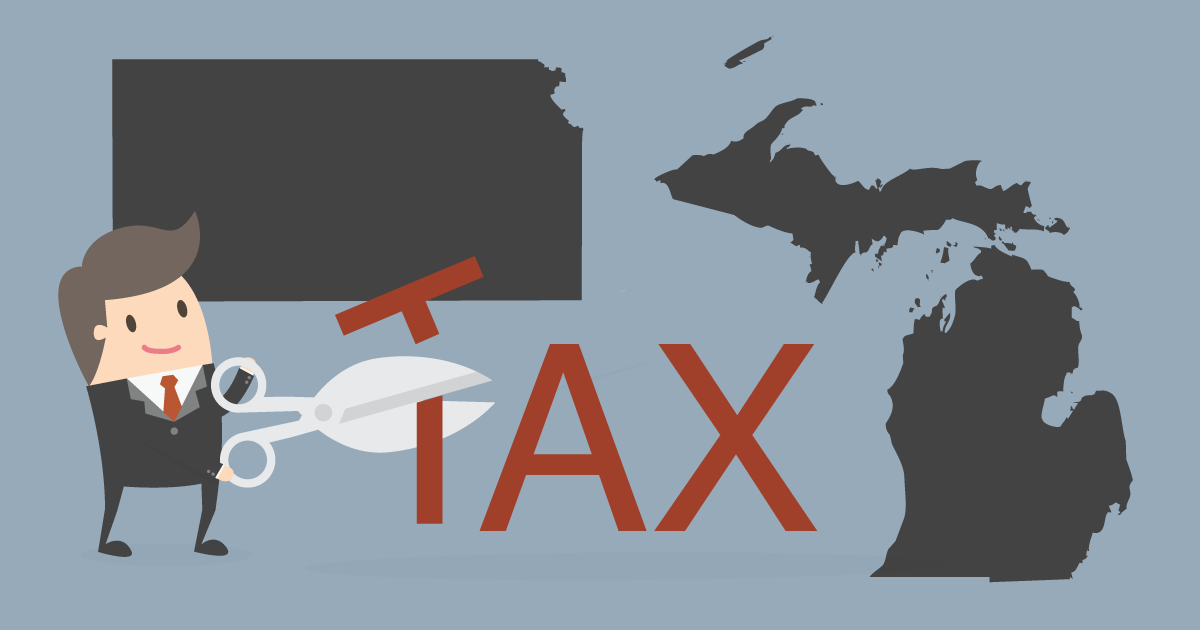As we have explored previously (see here, here and here), Kansas tried and failed to grow their economy through big tax cuts. In fact what they got was the exact opposite, arguably the worst state economic performance since the end of the Great Recession.
Despite the overwhelming evidence that cutting taxes doesn’t grow state economies, it seems like the Michigan legislature is hellbent on replicating the failed Kansas playbook. This time by eliminating the state income tax. Not smart!
Let’s quickly review what has happened in Kansas. This comes from a Bloomberg column by Barry Ritholtz, founder of Ritholtz Wealth Management. He writes:
In May 2012, he (Brownback) signed the bill into law. It initially lowered the top personal tax rate to 4.9 percent (it’s now 4.6 percent) from 6.45 percent, but most importantly, it eliminated income tax on profits for owners of limited liability companies, subchapter S corporations and sole proprietorships.
Give Brownback credit for passing the exact legislation he had promised.
The results, however, haven’t been very encouraging. Indeed, since the tax cuts were passed, almost nothing has gone as promised in Kansas. Revenue plunged and the state resorted to pulling money out of its rainy-day fund to plug the holes. A number of critical services, including for road maintenance and schools, were cut. The business climate has been poor, and the economy has lagged behind neighboring states as well as the rest of the country.
… The math is simple: Tax cuts tend to reduce revenue, in Kansas’ case much more than expected. To change people’s behavior requires more substantial incentives than changing things by a few percentage points. The reduced revenue led to spending cuts that lowered quality of life. In response, rising numbers of people and companies have left the state.
Ritzholtz details the economic underperformance of Kansas since the tax cuts:
- Kansas’ gross state product fell behind the six-state region and the nation for the third straight year. (Kansas’ gross state product grew at a faster rate when compared to the region and the nation in three of the five years before Brownback took office in 2011).
- Private industry wages in Kansas grew at a slower pace last year than they did in the region and the U.S. — as they did during the past five years.
- The number of private business establishments in Kansas trailed both the region and the nation for the last year, again continuing a five-year trend
Why did the experiment fail? As Ritzholtz explains: “Alas, reality trumps theory. As we have seen almost every time this thesis has been put into practice, it fails. The tax cuts don’t magically kick the economy into higher gear and the government ends up short of money. Remember former President George W. Bush and his tax cuts? Same deal. … The bottom line: The results from the economic laboratory known as Kansas are in. Supply side theory — and Kansans — lost.” (Emphasis added.)
At the same time that Kansas was slashing taxes, California and Minnesota were raising theirs. In both cases, mainly higher income taxes on households with the highest incomes. What the tax cutters repeatedly tell us is the worse thing you can do to a state economy. Think again!
California arguably has had the best recovery of any state since the end of the Great Recession. The Washington Post reported:
California’s economy grew by 4.1 percent in 2015, according to new numbers from the Bureau of Economic Analysis, tying it with Oregon for the fastest state growth of the year. That was up from 3.1 percent growth for the Golden State in 2014, which was near the top of the national pack.
The Kansas economy, on the other hand, grew 0.2 percent in 2015. That’s down from 1.2 percent in 2014, and below neighboring states such as Nebraska (2.1 percent) and Missouri (1.2 percent). Kansas ended the year with two consecutive quarters of negative growth — a shrinking economy. By a common definition of the term, the state entered 2016 in recession.
And then there is Minnesota. It, as we detailed in our State Policies Matter report, has, by far, the strongest economy and the highest taxes in the Great Lakes. The lowest unemployment rate, the highest proportion of adults working, the highest per capita income and lowest poverty rate.
Michigan policymakers should have learned by now that cutting taxes is not effective in growing state economies from our own experience as well. We have been trying this playbook since the late 1990s. The result: Michigan for the first time ever is a low prosperity state with a strong Detroit Three. The last time the Detroit Three was thriving in 2000 Michigan had a per capita income at the national average. Today, having gone from a high tax state to a low tax state (see this Citizens Research Council report), Michigan is eleven percent below the national average. And there are roughly 400,000 fewer jobs in Michigan today than in 2000.
So no the states with the lowest taxes don’t have the best economies. And definitely states without income taxes are not the most prosperous.
What correlates far better with high state prosperity is talent. The states with the highest education attainment.
As we have written frequently (see this 2010 post, this from 2014, and this from 2016) what matters is what you get from higher taxes. Yes there are benefits you get from taxes. The places with the strongest economies are those that combine high quality education systems and high quality of place that retains and attracts mobile talent. (And are also welcoming to all.) Both education and placemaking require public investments. These kind of public investments, paid for by our taxes, is the state policy playbook most likely to return Michigan to high prosperity, not more of the failed Michigan and Kansas tax cut after tax cut recipe.







